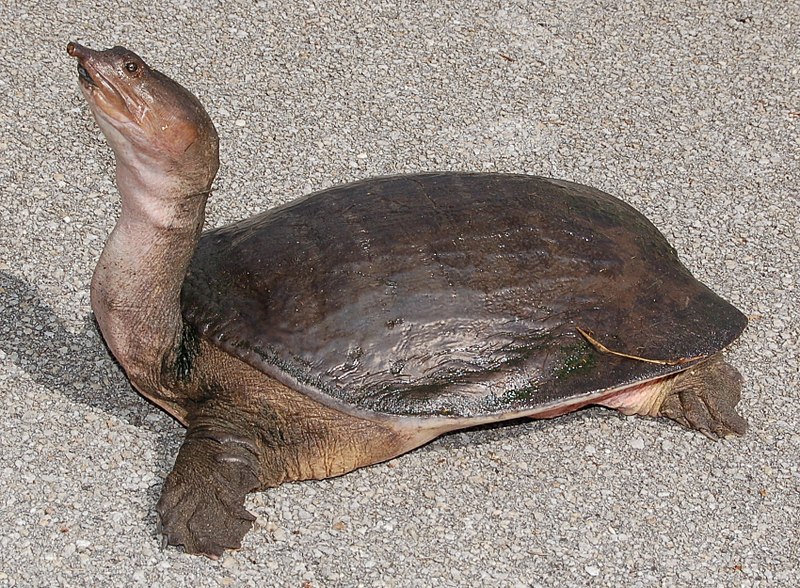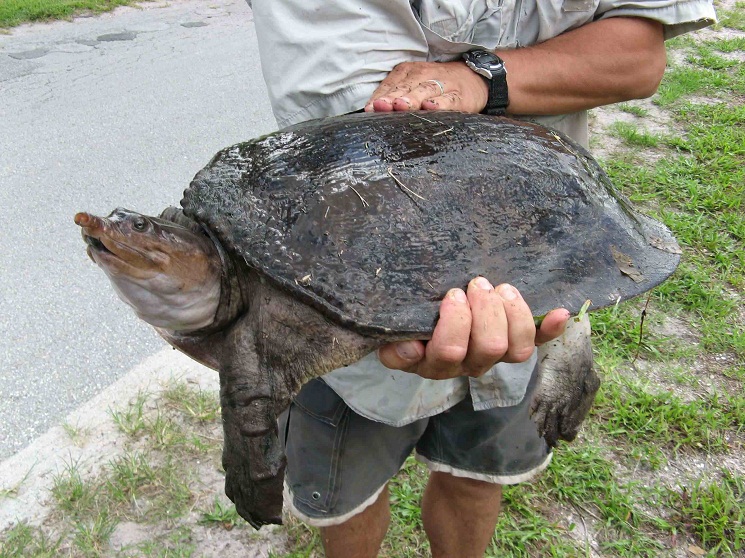How Fast Are Florida Softshell Turtles?
Florida softshell turtles may not be the first creatures that come to mind when you think of speed, but don’t let their smooth, pancake-like appearance fool you. These fascinating reptiles are surprisingly quick swimmers. In fact, they are known for their impressive agility in the water. So, just how fast are Florida softshell turtles? Let’s dive in and explore the remarkable speed of these unique creatures.
When it comes to swimming, Florida softshell turtles are no slouches. With their streamlined bodies and webbed feet, they can zip through the water with surprising speed. These turtles are capable of reaching speeds of up to 15 miles per hour (24 kilometers per hour) when they’re in their element. That’s faster than the average human running speed! It’s incredible to think that these seemingly slow and steady creatures can move so swiftly in their aquatic habitat.
So, whether you’re a nature enthusiast or simply curious about the world around you, learning about the speed of Florida softshell turtles is sure to amaze you. These agile swimmers are a testament to the diversity and adaptability of the animal kingdom. So, the next time you spot a Florida softshell turtle gliding through the water, take a moment to appreciate the grace and speed of this remarkable creature.

How Fast Are Florida Softshell Turtles?
Florida softshell turtles, scientifically known as Apalone ferox, are fascinating creatures that inhabit freshwater bodies throughout Florida and other southeastern states. These turtles are known for their unique appearance, with soft, leathery shells and long, snorkel-like noses that protrude from the water’s surface. While they may not be the fastest swimmers in the animal kingdom, Florida softshell turtles are surprisingly agile in the water. In this article, we will explore the average speed of Florida softshell turtles and dive into the factors that influence their swimming abilities.
The Swimming Speed of Florida Softshell Turtles
Florida softshell turtles are known to be relatively fast swimmers compared to other turtle species. They have streamlined bodies and webbed feet that enable them to navigate through the water with ease. On average, these turtles can reach speeds of up to 15 miles per hour (24 kilometers per hour) when swimming at their maximum capacity. This impressive speed allows them to swiftly move through the water and effectively hunt for prey.
Several factors contribute to the swimming speed of Florida softshell turtles. Firstly, their streamlined bodies reduce drag, allowing them to glide through the water more efficiently. Additionally, their long, webbed feet provide ample propulsion, enabling them to generate significant forward thrust. The combination of these physical adaptations makes them adept swimmers, especially when compared to other turtle species.
Factors Influencing the Swimming Speed of Florida Softshell Turtles
1. Size and Age: Younger Florida softshell turtles may be faster swimmers than their older counterparts. As turtles grow larger, their size can affect their agility and speed in the water.
2. Habitat: Florida softshell turtles are primarily found in freshwater habitats such as lakes, ponds, and slow-moving rivers. The characteristics of their habitat, such as water currents and vegetation, can influence their swimming speed.
3. Temperature: Like many reptiles, Florida softshell turtles are ectothermic, meaning their body temperature is regulated by the environment. Warmer water temperatures can increase their metabolic rate, potentially enhancing their swimming abilities.
4. Predators: The presence of predators can also impact the swimming behavior of Florida softshell turtles. When threatened, these turtles can exhibit bursts of speed to evade capture.
5. Food Availability: The availability of food sources can influence the swimming patterns of Florida softshell turtles. They may swim faster when actively foraging or pursuing prey.
It is important to note that individual turtles may exhibit variations in swimming speed based on their physical condition and environment. While the average speed of Florida softshell turtles is estimated to be around 15 miles per hour, it is essential to consider these factors when assessing their swimming capabilities.
Benefits of Fast Swimming for Florida Softshell Turtles
Being able to swim quickly provides several advantages for Florida softshell turtles. Firstly, their speed allows them to actively search for food sources, which primarily consist of small fish, insects, crustaceans, and aquatic vegetation. By swimming at higher speeds, they can cover larger areas and increase their chances of locating prey.
Fast swimming also aids in predator avoidance. Florida softshell turtles are preyed upon by various animals, including larger turtles, birds, mammals, and even alligators. Their ability to quickly escape potential threats by swimming at higher speeds can significantly increase their chances of survival.
In addition to these benefits, fast swimming can also contribute to reproductive success. Male turtles often engage in territorial disputes during the breeding season, and swimming speed can play a role in establishing dominance and securing mates.
Tips for Observing Florida Softshell Turtles in the Wild
1. Be patient: Florida softshell turtles are often found basking on logs or rocks near the water’s edge. Take your time and observe from a distance to avoid disturbing them.
2. Respect their space: Avoid touching or handling the turtles, as this can cause stress and disrupt their natural behavior.
3. Use binoculars or a camera with a telephoto lens: Getting a closer look without intruding on their habitat allows for better observation and photography opportunities.
4. Observe from a kayak or canoe: By approaching quietly on the water, you can observe these turtles up close without causing disturbance.
5. Learn about their habitat: Understanding the environments where Florida softshell turtles thrive can increase your chances of encountering them in the wild.
By following these tips, you can have a rewarding and respectful experience observing Florida softshell turtles in their natural habitat.
Overall, Florida softshell turtles are impressive swimmers, capable of reaching speeds of up to 15 miles per hour. Their streamlined bodies, webbed feet, and other physical adaptations make them well-suited for life in the water. Understanding their swimming abilities and the factors that influence them can provide valuable insights into the lives of these fascinating reptiles. So the next time you encounter a Florida softshell turtle, take a moment to appreciate the remarkable speed at which they navigate their aquatic world.
Key Takeaways: How fast are Florida softshell turtles?
- Florida softshell turtles are known for their impressive speed in water.
- These turtles can swim at speeds of up to 15 miles per hour.
- They have a streamlined body shape and webbed feet that aid in their fast swimming ability.
- On land, Florida softshell turtles are not as fast and can move at a moderate pace.
- Their speed on land is influenced by their size, age, and environmental conditions.
Frequently Asked Questions
How do Florida softshell turtles move?
Florida softshell turtles are known for their impressive swimming abilities. They move through water by propelling themselves with their powerful webbed feet. Their streamlined body shape allows them to glide effortlessly through the water, reaching impressive speeds. When on land, they use their strong limbs to crawl and walk, but they are much faster and more agile in their natural aquatic habitat.
These turtles are also capable of burrowing in the sand or mud, using their sharp claws and strong muscles. Burrowing helps them find shelter and protection from predators, and it’s another way they can move around in their environment.
What is the average speed of a Florida softshell turtle?
The average speed of a Florida softshell turtle varies depending on various factors, including their size, age, and external conditions. On average, they can swim at speeds of around 10-15 miles per hour. This speed allows them to navigate their habitats efficiently and catch prey. However, it’s important to note that not all turtles will consistently swim at maximum speeds, as they may adjust their pace according to their needs and energy levels.
It’s worth mentioning that Florida softshell turtles are known for their bursts of speed and agility rather than sustained high-speed swimming. They are ambush predators, relying on their quick bursts of speed to capture prey rather than engaging in long chases.
Can Florida softshell turtles swim faster than other turtle species?
Florida softshell turtles are among the fastest turtle species in the world. Their streamlined shape and powerful limbs allow them to swim at impressive speeds. While the exact comparison with other turtle species may vary, Florida softshell turtles are known for their exceptional swimming abilities, which enable them to outrun many potential predators and catch their prey.
It’s important to note that different turtle species have varying adaptations and capabilities, so their swimming speeds will differ. However, the Florida softshell turtle’s unique features make it one of the fastest swimmers in the turtle kingdom.
What factors affect the speed of Florida softshell turtles?
Several factors can influence the speed of Florida softshell turtles. One significant factor is their size. Larger turtles generally have more mass to move through the water, which can affect their overall speed. Additionally, the age and health of the turtle can also impact their speed. Younger turtles may be more agile and faster swimmers compared to older individuals.
Environmental conditions can also play a role. Water temperature, water quality, and the presence of obstacles or currents can affect a turtle’s swimming speed. In optimal conditions, with suitable water temperature and minimal obstacles, Florida softshell turtles can showcase their full swimming potential.
How do Florida softshell turtles hunt their prey?
Florida softshell turtles are carnivorous and have a unique hunting strategy. They are ambush predators, lying in wait for their prey to approach. When an opportunity arises, they quickly and forcefully strike at their prey, using their sharp beak-like mouth to capture it. Their bursts of speed, combined with their strong jaws, allow them to catch fish, crustaceans, insects, and other small aquatic animals.
These turtles have excellent vision and can detect movement in the water, making them efficient hunters. Once caught, they consume their prey whole or tear it into smaller pieces using their sharp beak. Their hunting strategy relies on their ability to swiftly maneuver and capture prey, showcasing their speed and agility in the water.

OWNING A *SOON TO BE* 2ft FLORIDA SOFT SHELL TURTLE!
Final Summary: How Fast Can Florida Softshell Turtles Move?
So, how fast are Florida softshell turtles? Well, these remarkable creatures are no slouches when it comes to speed! While they may not be breaking any land speed records, they are surprisingly agile in the water. With their streamlined bodies and webbed feet, these turtles can swim at impressive speeds, effortlessly gliding through their aquatic habitat.
When it comes to their speed on land, Florida softshell turtles are not as quick as they are in the water. On land, they tend to move at a more leisurely pace, using their strong legs to slowly crawl across the terrain. However, don’t let their relaxed demeanor fool you. These turtles are still capable of surprising bursts of speed when they need to make a quick getaway or find a new spot to bask in the sun.
In conclusion, while Florida softshell turtles may not be the fastest creatures in the animal kingdom, they are perfectly adapted to their aquatic lifestyle. Their ability to navigate the water with impressive speed and grace is a testament to their unique anatomy and natural abilities. So, the next time you spot a Florida softshell turtle in the wild, take a moment to appreciate their remarkable swimming skills and their ability to move at their own pace on land.

